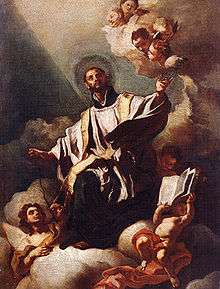Saint Cajetan
| Saint Cajetan | |
|---|---|
 Saint Cajetan | |
| Confessor | |
| Born |
October 1, 1480 Vicenza, Veneto, Republic of Venice (now Italy) |
| Died |
August 7, 1547 (aged 66) Naples, Campania, Kingdom of Naples |
| Venerated in | Roman Catholic Church |
| Beatified | October 8, 1629, Rome by Pope Urban VIII |
| Canonized | April 12, 1671, Rome by Pope Clement X |
| Feast | August 7 |
| Patronage | bankers; gamblers; unemployed people; workers; non-gamblers; document controllers; job seekers; ; Albania; Italy; Ħamrun (Malta); Argentina; Brazil; El Salvador; Guatemala |
Gaetano dei Conti di Thiene (October 1, 1480 – August 7, 1547), was an Italian Catholic priest and religious reformer, who helped found the Theatines. He is recognised as a saint in the Catholic Church, and his feast day is August 7.
Life
St. Cajetan was born in October 1480, the son of Gaspar, lord of Thiene, and Mary Porta, persons of the first rank among the nobility of the territory of Vicenza, in Lombardy.[1]
His father died when he was two years of age. Quiet and retiring by nature,[2] he was predisposed to piety by his mother. Cajetan studied law in Padua, receiving his degree as doctor utriusque juris (i.e., in civil and canon law) at age 24. In 1506 he worked as a diplomat for Pope Julius II, with whom he helped reconcile the Republic of Venice.[3] But he was not ordained a priest until the year 1516.
With the death of Pope Julius II in 1513. Cajetan withdrew from the papal court.[3] Recalled to Vicenza by the death of his mother, he founded in 1522 a hospital for incurables there.[4] By 1523 he had established a hospital in Venice, as well. His interests were as much or more devoted to spiritual healing than the physical kind, and he joined a confraternity in Rome called the "Oratory of Divine Love".[1] He intended to form a group that would combine the spirit of monasticism with the exercises of the active ministry.
Theatines
A new congregation was canonically erected by Pope Clement VII in the year 1524. One of his four companions was Giovanni Pietro Carafa, the Bishop of Chieti, elected first superior of the order, who later became pope as Paul IV. From the name of the city of Chieti (in Latin: Theate), arose the name by which the order is known, the "Theatines".[4] The order grew at a fairly slow pace: there were only twelve Theatines in 1527 during the sack of Rome in 1527, during which Cajetan was tortured by the Spanish soldiers of Charles V.[5] The Theatines managed to escape to Venice.[4]
There Cajetan met Jerome Emiliani, whom he assisted in the establishment of his Congregation of Clerks Regular. In 1533 he founded a house in Naples. The year 1540 found him in Venice again and from there he extended his work to Verona.[3] He founded a bank to help the poor and offer an alternative to usurers (loan sharks).[6] It later became the Bank of Naples.
Cajetan died in Naples on August 7, 1547.[6] His remains are in the church of San Paolo Maggiore in Naples; outside the church is Piazza San Gaetano, with a statue.
Veneration
He was beatified on October 8, 1629, by Pope Urban VIII. On April 12, 1671, Cajetan was canonized[6] together with Rose of Lima, Luis Beltrán, Francis Borgia and Felipe Benicio. Saint Cajetan's feast day is celebrated on August 7.
Patronage
He is known as the patron saint of Argentina, the unemployed,[7] non-gamblers, document controllers, and good fortune.
See also
References
- 1 2 Butler, Alban. Lives of the Saints, Vol. VIII, 1866
- ↑ Lewis, Mark A., "Recovering the Apostolic Way of Life", Early Modern Catholicism: Essays in Honour of John W. O'Malley, S.J., (John W. O'Malley, Kathleen M. Comerford, Hilmar M. Pabel eds.), University of Toronto Press, 2001, ISBN 9780802084170
- 1 2 3 Keating, Joseph. "St. Cajetan." The Catholic Encyclopedia. Vol. 3. New York: Robert Appleton Company, 1908. 15 Apr. 2013
- 1 2 3 Foley O.F.M., Leonard. Saint of the Day, Lives, Lessons, and Feast, (revised by Pat McCloskey O.F.M.), Franciscan Media, ISBN 978-0-86716-887-7
- ↑ Mullet, Michael. The Catholic Reformation, Routledge, 2002, ISBN 9781134658534
- 1 2 3 "St. Cajetan", Catholic News Agancy
- ↑ Wooden, Cindy. "Pope joins pilgrims -via video- at Shrine of St. Cajetan", Catholic News Service, April 7, 2013
External links
- http://www.malta-canada.com/san-gaetano/Index-S-G.htm
- Biography of St Cajetan (Spanish)
- "Pope Francis' Message for the Feast of Saint Cajetan", Zenit, August 7, 2013
- Colonnade Statue in St Peter's Square
- Founder Statue in St Peter's Basilica
|